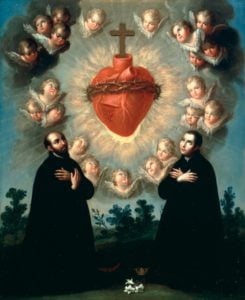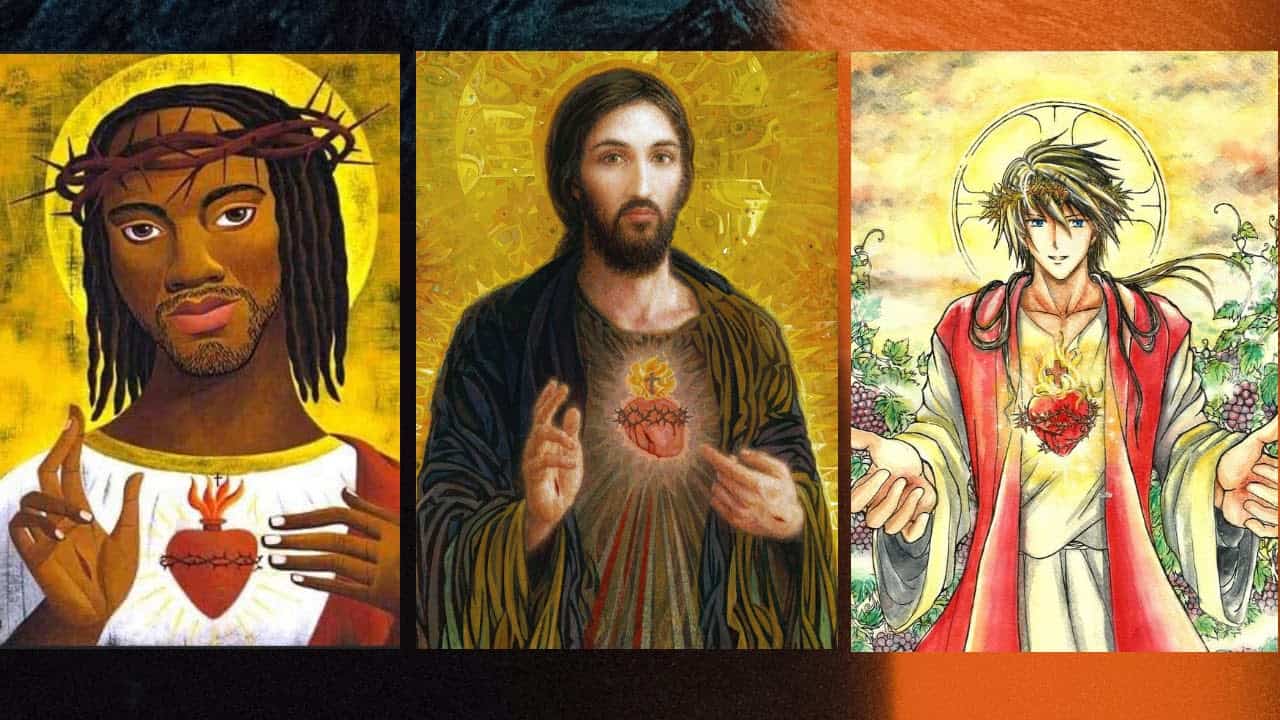The Jesuits (and also Franciscans) have a long and fascinating history of promoting the Devotion to the Sacred Heart of Jesus. It was so important, explicit mention of the devotion was added into the Constitutions of the Society of Jesus: “All should have a high regard for, and be keenly mindful of, the mystery of the Heart of Christ… promot[ing] it in their every apostolic activity.” 1 Jesuits like Fr. Pedro Arrupe, SJ 2 and Fr. Karl Rahner, SJ 3 placed great emphasis on the power and importance of the Sacred Heart as well. In fact, Fr. Karl Rahner, SJ once wrote that the “Sacred Heart of Jesus is not just another devotion, it is the spirituality that defines the Church.”

Sacred Heart of Jesus with Saint Ignatius of Loyola and Saint Louis Gonzaga (José de Páez, Mexico, 1727-1790)
I invite our readers today to learn about this ‘Most’ Human and ‘Most’ Divine Heart, not through trivia or history about this devotion, but through prayer — as a ‘friend to a friend’ or ‘heart to heart’. 4 This is the “interior knowledge” of Christ 5 which the Spiritual Exercises encourage us to experience — not just to know about Jesus, but to know him personally. Although St.
Ignatius himself would not have seen the image of the Sacred Heart as we know it today, the practice of this devotion is incredibly Ignatian: “For it is not much knowledge that fills and satisfies the soul, but the intimate understanding and relish of the truth.” 6
I suggest this approach is the key to understanding and truly living the devotions to the Most Sacred Heart of Jesus. 7
A ‘Radical’ Prayer Based on the Heart of Christ
The “core” of this devotion known as the “Cor Iesu Sacratissimum” is the heart (“cor” in Latin) of Jesus. The Sacred Heart captures the central element of Christ: God’s infinite love in a living human heart 8. That’s his salvific gift to the world. Whenever we see this heart, we are to recall that Christ always “sees” our own hearts first (Mark 10:21). In fact, we too are called to do the same with everyone and not judge a book by its cover. And Jesus does mean every ‘one’ we meet (John 13:34-35).
Using a method known as the ‘Ignatian Examen’, my hope is that this prayer transforms the way we understand our relationship with the Most Sacred Heart 9 — i.e. our relationship with Christ himself. So that everytime I see this image I am reminded of the goal of all Christian living: To re-create my own heart in the “image and likeness” 10 of the heart of Christ!
Anatomy of the Sacred Heart

There are three main parts to the Most Sacred Heart of Jesus, which we can use daily to Examine our own hearts:
-
-
-
- A Heart set on fire
-
-
- A Heart crowned with thorns
- A Heart that is exposed and vulnerable outside of the body
Opening Prayer (while doing the Sign of the Cross slowly): “God the Father, send your Holy Spirit to create in us a heart that resembles that of your Son, Jesus”
Step 1: Contemplate the Fire of the Heart
“I have come to set the earth on fire, and how I wish it were already blazing!” (Luke 12:49)
Reflection: Jesus was always on fire for God’s Kingdom and God’s Justice (Matthew 6:33). The things of God oriented everything Jesus did. He was indeed a man filled with great passion for the work of his Father! (John 5:17). Here are some questions that can help us reflect on our own hearts in light of that roaring and unquenchable flame:
- Where has my heart been set on ‘fire’ with love, peace or joy today?
- Have I felt God’s presence — an increase of faith, hope and love?
- Have I felt God’s absence — a decrease of faith, hope and love?
- What kind of activities have I been passionate about?
- Are these things Jesus himself would be passionate about?
Prayer: Lord, help my heart become “flammable” with the fire of the Holy Spirit so that I too experience that life-giving love between the Father and the Son (John 15:9).
Step 2: Contemplate the Thorns Crowning the Heart
“So Jesus came out, wearing the crown of thorns and the purple cloak. And Pilate said to them, “Behold, the man!” (John 19:5)
Reflection: Right before his Passion, Jesus’s feet are ‘anointed’ with a pint of expensive nard oil (John 12:3) by Mary, Martha’s sister — equivalent to a year’s worth of salary. This kind of oil was used for very important and (very different) types of ceremonies, including coronations, ordinations, weddings and even burial ceremonies. This same scene appears in Mark 14:3, but with an unnamed woman who breaks the jar and pours it, this time on his head. From head to feet, Jesus was justly anointed as ‘Lord’ in Bethany, whereas in Jerusalem, he is unjustly mocked with a crown of thorns by unnamed Roman soldiers (Matthew 27:29). The fact that both the woman and the soldiers are unnamed allow us to place ourselves there: we continue to ‘anoint’ and ‘mock’ Christ as well in our daily lives. And yet, Jesus received both with equal love — the woman and the soldiers. Both were essential to signal his divine Kingship over the universe.
Christ is king of the just and unjust alike. His “broken heart” 11 and thorns can represent those moments of sacrifice or struggle for and with others.
- What have I sacrificed today? Is there something I have resisted sacrificing?
- Is there someone else who has sacrificed something for me — i.e. a parent, friend or loved one? I hold them with deep gratitude in my heart at this moment.
- Do I allow myself to feel the pain of so many “crucified” and unjustly treated peoples in our world or do I close my heart’s eyes and ears to injustice? How well do I hear “the cry of the poor”12?
- When I look upon my own heart’s ‘wounds’ do I pray just to be healed or that my ‘wounds’ are used by God to serve the world?
- How well do I receive both “blessings” and “hardships” in my heart? Do I receive them with equal love?
Prayer: Lord, just as royal myrrh (Matthew 2:11) is extracted from a tree of thorns, transform our pains and sacrifices into opportunities to ‘praise, reverence and serve You’ without costing the cost.
Step 3: Contemplate the Heart Outside the Chest
“Then he took the bread, said the blessing, broke it, and gave it to them, saying, “This is my body, which will be given for you.” (Luke 22:19)
Reflection: In the case of Jesus, we can see what his heart looks like because he does not hide it from others. He wears it not only on his sleeve, but on his chest — so that you cannot miss it. This level of vulnerability leaves his heart for others to touch, see and be close to — i.e. exposed to kisses and violence, acceptance and rejection, friendship and betrayal. Focusing on the ‘heart’ (essence) of the other first can help us transcend religious, socio-economic, racial and other exterior divisions. It is an artistic summary of the ‘Great Commandment’ to love God, others and self as one (Matthew 22:34-40). All human love and divine love is fused in this one heart. But Jesus clearly does not reserve this heart for himself, he gifts it away — always.
- How vulnerable and open am I with my own heart?
- Have I hidden my heart from anyone today?
- Is there someone or something I am afraid of giving my ‘whole’ heart to?
- Has there been anyone today who has given their heart to me through their time, service or just a smile?
- How does God invite me to greater vulnerability?
- Knowing Christ gifts me his “messy” heart (i.e. bloodied and broken), am I willing to give mine (i.e. however its state) to God and others?
Prayer: Lord, transform my heart into a Eucharistic Heart — one that is “blessed, broken and shared” (Mark 14:22) 13 for all and with all without reserve and conditions.
—-
What if my Heart still Hungers for More?
If you are still hungry, this is Good News! Your heart is becoming more like the heart of Our Lord, who until his last breaths was “hungry” (Mark 11:12) and “thirsty” (John 19:28) for the conversion of hearts and the installment of the Kingdom. This longing for righteousness and justice is a Beatitude that screams of the Ignatian “Magis” — always seeking ‘the more’ (depth over breadth) in everything and everyone.
This divine love is contagious and it is this love that changes a ‘work of art’ into a ‘work of devotion’ — transforming our own hearts into God’s own artwork.
For those who wish to continue plummeting the depths of this eternal and inexhaustible well of living water and wisdom 14, here are some solid Ignatian Prayer Resources and Book Recommendations to continue setting our (internal) world on fire first!
———
Image credits:
a. Covert Art of Three Sacred Hearts: (Left to Right): Unknown Artist, Smith Catholic Art, & Dark-Kanita]
Editor’s Note: updated 14 June 2021 at 8:24am CST
- Complimentary Norms 276 ↩
- Fr. Pedro Arrupe, SJ (who is currently in the process of being beatified) renewed the Society of Jesus’s consecration to the Sacred Heart on June 9, 1972 — 100 years after our initial Consecration — stating that Jesuits have “the duty of reflecting seriously on what is essential in the Sacred Heart devotion and of finding ways to channel and present it to the world of today”. Check out his deeply moving letter to the Jesuits worldwide. ↩
- Read more on Karl Rahner’s fascinating Theology of the Sacred Heart Devotion. ↩
- Spiritual Exercises, 54 ↩
- Spiritual Exercises, 104 ↩
- Spiritual Exercises, 2 ↩
- Jesus’s Sacred Heart is one of the most diversely ‘interpreted’ images in art: i.e. ranging from car decals to funeral cards, paintings in dining rooms to “estampitas” (Latino grandmother’s saint cards) hanging on bathroom mirrors. At the same time, this might also be one of the most ‘misinterpreted’ Catholic devotions, sometimes becoming synonymous with overly pious and sentimentalized images of Jesus. Yet, the point of the Sacred Heart Image is not to focus on Jesus’s exterior, but rather his interior. ↩
- The “heart” represents the center from which our lives flow: i.e. Luke 21: 34, Acts 14: 17, James 5: 5 ↩
- Be patient, this relationship between the Sacred Heart and ourselves will grow slowly over time. For example, even though I learned about the Sacred Heart from the Religious sisters as a kid in CCD and would pray the “Act of Consecration” everyday on the way to school (for over five years) with my mother, I would only come to begin to understand the importance of this devotion in my life during the Spiritual Exercises as a Jesuit Novice. ↩
- Genesis 1:26 ↩
- St. Thomas Aquinas also highlighted the significance of Jesus resurrecting with his ‘wounds’ (ST III, q. 54, a. 4). Pope Francis himself said during a homily to the Poor Sisters of St. Clare in 2013 that “Jesus took his wounds to heaven!” One important question the Sacred Heart devotion asks us is how can my “resurrected” wounds become channels of grace for others? ↩
- Proverbs 21:13 ↩
- Check out a short (but deep) Ignatian Examen based on the words: ‘Taken, Blessed, Broken, Given’. ↩
- I highly recommend reading Pope Pius XII’s inspiring (but long) Encyclical “Haurietis Aquas” on the Devotion to the Sacred Heart (1956) for a history of the devotion and its role in the Church ↩


